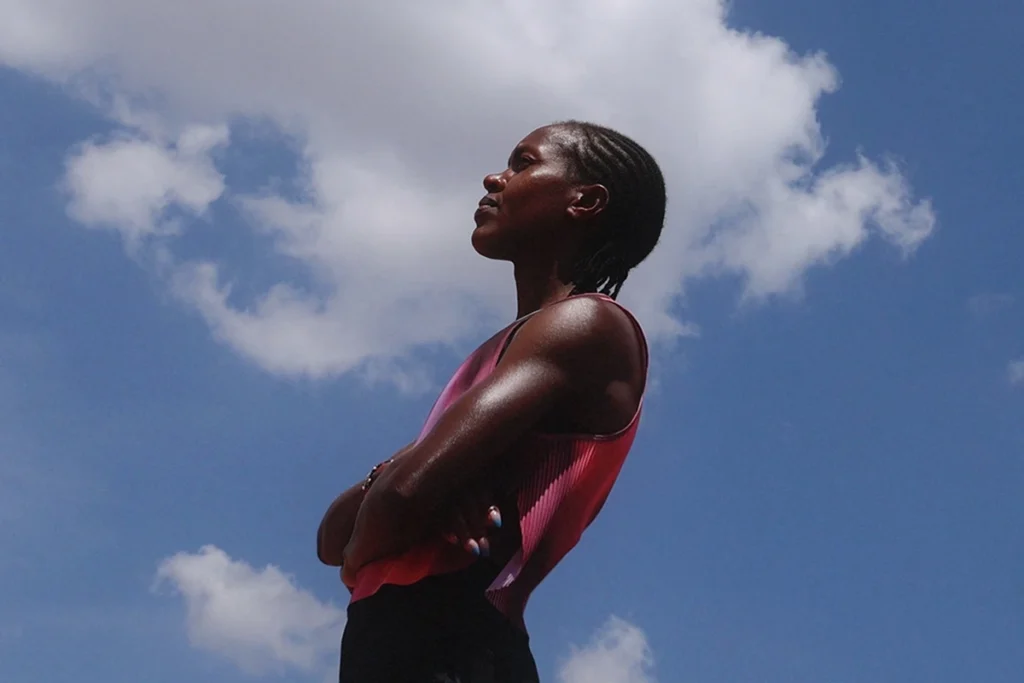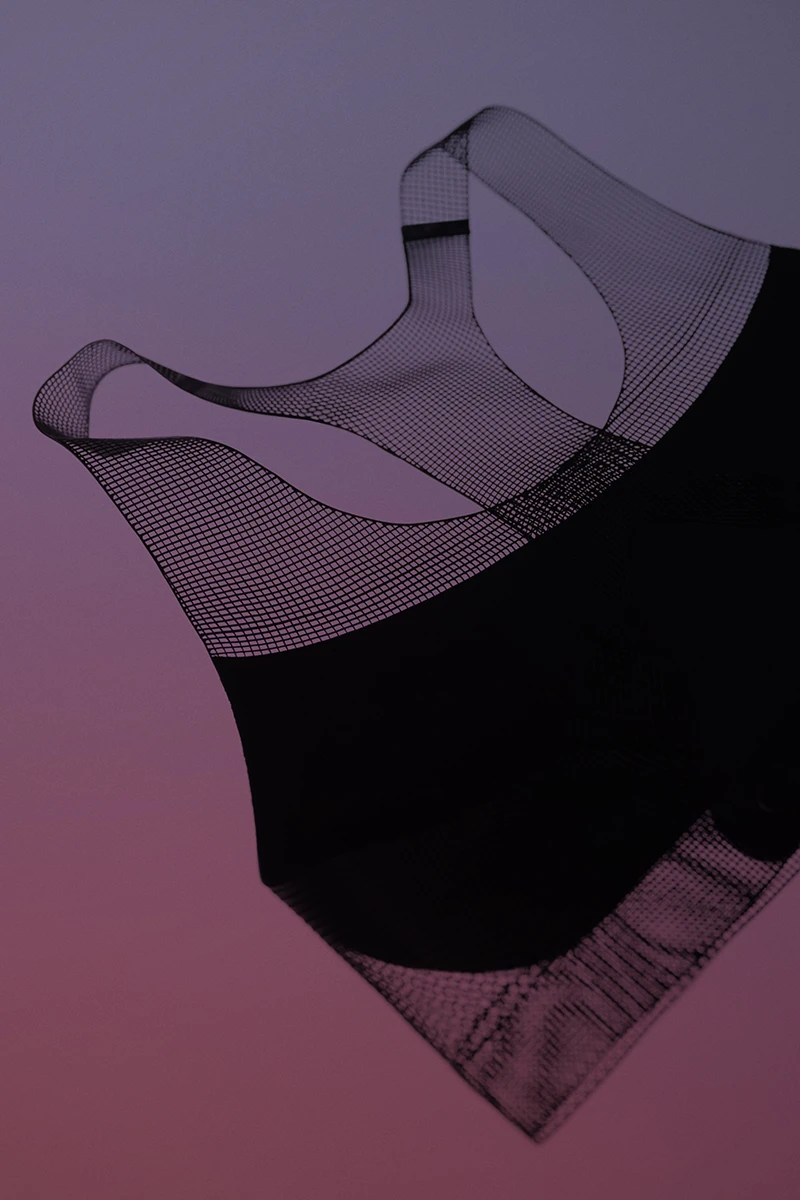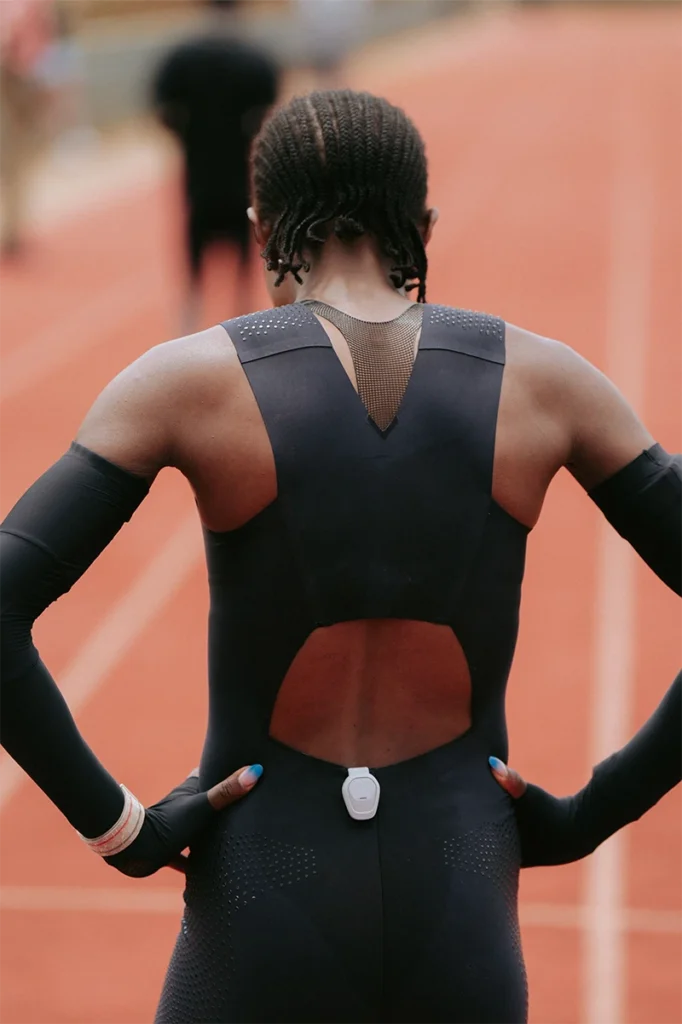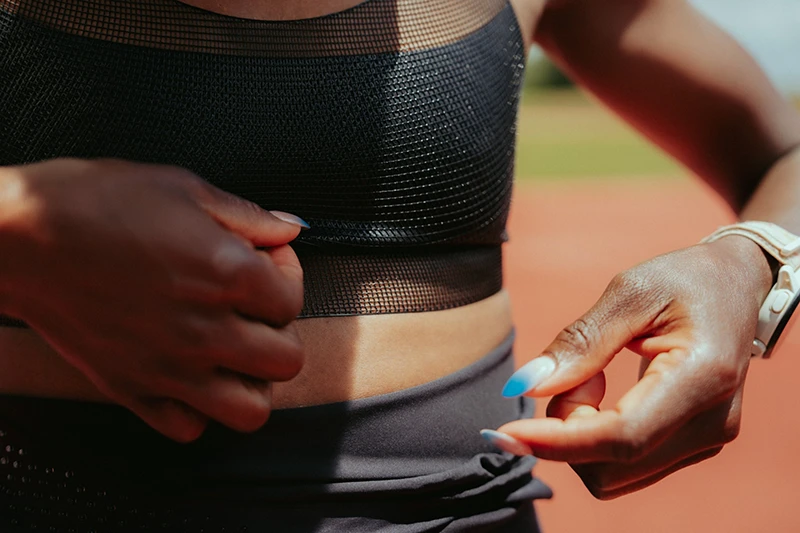Marketing Hype vs. Measurable Gains
Paris, 26 June 2025.
Faith Kipyegon barrels into the bell lap of her sub‑4:00‑mile attempt, cameras locked on the sleek black “Breaking4” speedsuit. Hidden underneath is Nike’s FlyWeb bra—a one‑of‑one lattice of thermoplastic polyurethane (TPU) that, according to Nike, delivers a “sensory shift,” “air‑cooled support,” and a “new era in women’s running tech.”
Big promises. But is FlyWeb a legitimate biomechanical breakthrough or just another supershoe‑style arms race wrapped in pink empowerment? We sifted through patents, lab notes, World Athletics rule books, fatigue studies, analyst memos, and—yes—Twitter hot‑takes to separate fact from flash.

FlyWeb in 60 Seconds: Spec Sheet—and Red Flags
What Nike Claims
- Construction: Single‑piece racerback printed from a TPU lattice.
- Weight & feel: “Feather‑light, second‑skin softness.” [Nike]
- Performance: Zoned density—thicker ribs where support matters, airy cells elsewhere.
What Nike Doesn’t Say
- Sample size: One (Faith Kipyegon).
- Peer review: None.
- Metrics: No published data on bounce‑reduction, VO₂ cost, or durability.
| Hype Meter | ★★★★☆ |
|---|---|
| Initial spark scores high—but independent evidence is thin. |
3D Printing: Science or Showmanship?
Custom‑Fit Logic (The Good)
Additive manufacturing allows millimetre‑by‑millimetre control of lattice density. In theory, Nike could print a FlyWeb for every cup size and rib‑cage shape, solving the “one‑size‑fits‑few” curse of sports bras.
The Hype‑Cycle Reality
Gartner’s 2024 Hype Cycle for 3D‑Printed Fashion places “additive apparel” on the Slope of Enlightenment—still years from mainstream adoption. Roughly 90 % of flashy prototypes never reach retail. Investors know the script.
Keyword cluster to watch: 3D‑printed sports bra market, additive apparel sustainability.
TPU Lattice Engineering: Breakthrough—or Break‑Down Risk?

TPU Pros
- Elastic rebound hugs tissue without bulky foam.
- Hydrophobic—sweat won’t soak in like cotton or spacer mesh.
- Potentially recyclable.
Devil’s‑Advocate Bullets
- Fatigue danger: A 2023 MDPI study found significant strength loss in flexible TPU after 10 000 load cycles.
- Wash woes: Iowa State tests on 3D‑printed fabrics reported warping after ten home‑laundry cycles.
- Patent fine print: Nike’s US Patent 11 804 732 frames FlyWeb as “single‑event competition wear”—translation: it may be disposable.
Tough question: How many miles before FlyWeb squeaks, tears, or deforms? Nike hasn’t answered.
Lab Results Nike Did Share—and the Numbers They Didn’t
Nike touts “better moisture management than any textile.”
But:
- Bounce‑reduction %: Unreleased.
- Oxygen‑cost delta: Unreleased.
- Durability curve: Unreleased.
“Great concept, but data‑starved.”
—Dr Monica Allen, biomechanist (email interview, June 2025)
With an N = 1 test pool, statistically significant claims are impossible—yet the marketing rolls on.
Field Test in Kenya: Kipyegon’s Praise vs. Independent Eyes
“I’ve never worn something like this in my life. I love it.”—Faith Kipyegon after spring trials.
Sceptic’s counterpoint: A Nairobi‑based coach told us, “Drag reduction from a bra is negligible—maybe 0.01 s over a mile. Her real gains come from pacing and spikes.”
Nike’s highlight reel looks slick, but no blind A/B testing, motion sensors, or public data dashboards were provided—just PR footage.

FlyWeb vs. High‑Impact Bras: Side‑by‑Side Shoot‑Out
| Feature | FlyWeb Prototype | Retail High‑Impact Bra | Reality Check |
|---|---|---|---|
| Weight | Undisclosed; est. < 60 g | 110–140 g | Elite lightness may cost durability. |
| Support Tech | Variable TPU lattice | Molded foam & elastic | 0 bounce data released for FlyWeb. |
| Breathability | Large open cells | Mesh + wicking fabric | TPU could trap heat if cells clog with sunscreen/sweat. |
| MSRP | Not for sale | US $65–$80 | SLS print costs point to $200 +. |
| Life Cycle | Unknown wash life | > 40 washes typical | TPU fatigue still untested publicly. |
Mass‑Market Fantasy? Barriers Between FlyWeb and Your Drawer
- Print Time & Cost — Selective‑laser‑sintering TPU takes hours; unit economics suggest $150 + unless Nike shifts to multi‑nozzle batch printers.
- World Athletics Approval — Rule 6 demands homologation; Nike hasn’t announced submission.
- Sustainability Spin — On‑demand printing cuts scrap, but SLS machines guzzle energy and leftover powder degrades.
- Scan‑to‑Print Dreams — Patent sketches hint at a “Nike BraID” body‑scan app—still vaporware.
Voices from the Cheap Seats: Social & Wall‑Street Buzz
@tracknerd420: “$300 plastic cage under my singlet? Hard pass.”
@biomech_betsy: “Cool concept, but where’s the dataset? Publish or perish, Nike.”
An RBC Capital Markets memo calls FlyWeb an “innovation premium” play; shares could pop if Breaking4 goes viral but sink if R&D costs balloon without product rollout.
Cautionary memory: Adidas’ 2019 Futurecraft Bra never hit shelves—and investors remember.
Verdict: Disruptive Path Forward—or PR Masterclass?
Why It Could Matter
If Nike can validate its claims, FlyWeb’s lattice control might finally end the crude trade‑off between support and ventilation plaguing women’s running gear. For sub‑elite racers chasing hundredths of a second, shaving grams off the chest matters.
Why It Might Not
Without published bounce data, durability stats, or regulatory approval, FlyWeb risks becoming “Vaporfly for the chest”—tech that widens the gap between haves and have‑nots. Until Nike scales production and backs up the hype with numbers, FlyWeb looks more photo‑op than paradigm shift.
🏁 Subscribe for Articles Like This
Love deep‑dive gear analysis? Subscribe to our newsletter and receive fresh breakdowns on women’s running tech, biomechanics, and the stories behind sport‑science innovations—straight to your inbox.
No spam—just sharp insights and the occasional hot take.
❓ FlyWeb Bra FAQ
Not yet. As of June 2025, FlyWeb is a one‑off prototype worn only by Faith Kipyegon, with no retail timeline.
Analysts estimate $200–$250 USD per unit, given current selective‑laser‑sintering costs.
Not yet. Rule 6 requires advance homologation; Nike has not submitted FlyWeb for approval.
Nike has released no bounce‑reduction data, leaving performance claims unverified.
The TPU lattice is technically recyclable, but SLS printing consumes high energy and produces waste powder.
Key Sources
- Nike newsroom & “Behind the Design” (FlyWeb)
- MDPI: Journal of Polymer Testing (2023, TPU fatigue)
- Iowa State Digital Press (2023, washability study)
- Gartner: Hype Cycle for 3D‑Printed Fashion 2024
- World Athletics: Technical Rule 6
- Guardian coverage of Nike Breaking4 kit
- RBC Capital Markets analyst note on Nike innovation premium




